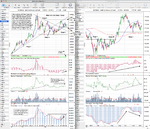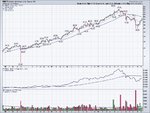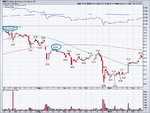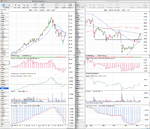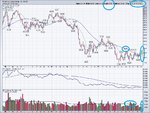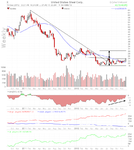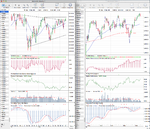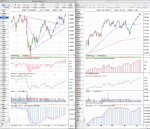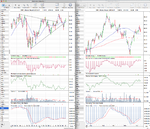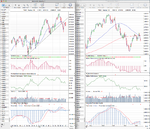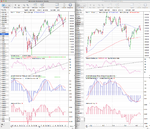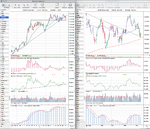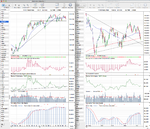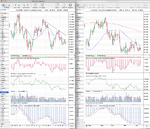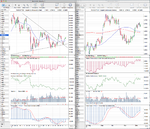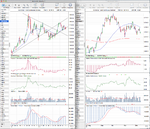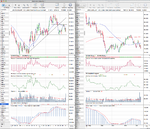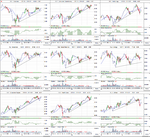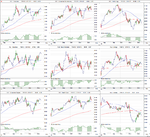Attached are the updated major charts for your own stage analysis and the relative performance table. The updated market breadth measures can be seen in the Market Breadth thread here:
http://www.trade2win.com/boards/technical-analysis/147476-market-breadth-19.html#post2035492
The following is my observations on the attached charts. You might or might not agree, but I find it useful to write down my analysis, and it gives me something tangible to review in the future.
I'll start with the major stock indexes in the US. The S&P 500 had a pop and drop week, ending slightly lower on hope that the Fed would do something more to prop up the faltering market. So the S&P 500 ran up into the announcement on Wednesday and then started to sell off as Bernanke was talking and continued lower for the next two days. On the daily chart you can see that it faltered at previous resistance around the 1430 zone from the September/October swing lows, and the November swing high, to close the week below the falling 50 day MA once again. If price breaks below last weeks low in the coming week, then last Wednesdays swing high at 1438.59 will define the top of the Stage 3 range for me personally, with the low of the range already defined by the November low of 1343.35
On the weekly chart you can see that price is just 3 points above a slightly up-sloping 30 week weighted MA and within one days average true range of the one trend line that was briefly violated in November. The momentum index continues to show a large divergence with the price action, and the 30 week weighted moving average momentum is also showing the same, barely moving above it's neutral point over the last 4 weeks and still under it's own declining 10 week MA. Cumulative volume (which is not shown on the chart) is also below it's own declining MA, and if you look at weekly force index here:
http://stockcharts.com/h-sc/ui?s=$SPX&p=W&b=5&g=0&id=p70181141506&a=247570490 then you can see that it is the weakest top (if it is a swing high that is) of the last three years by that measure; as it hasn't even managed to get above the zero line this time.
The Nasdaq 100 chart doesn't look much better either, and looks to be continuing it's Stage 4 decline after pulling back to test the 200 day MA over the last few weeks. AAPL
http://stockcharts.com/h-sc/ui?s=AAPL&p=W&b=5&g=0&id=p15674424399&a=286203674 has a big weighting in this index at almost a fifth of the index, and so it's own Stage 4 continuation move last week will weigh on the Nasdaq 100 performance if some downside momentum builds.
The Russell 2000 Small Caps are showing a bit more promise than the large caps and is outperforming slightly. However, the chart has most of the same problems as the S&P 500 and is close to it's 30 week MA and it's one year trendline. So if the others break down then it will likely too, as it's highly correlated to the S&P 500 at 93% on a 200 day average.
To the market breadth measures. The short term moving average breadth charts reversed last week giving bear alert signals on the S&P 500 and Nasdaq 100, and a bull correction signal on the broader NYSE Percent of Stocks Above their 50 Day Moving Average chart
http://stockcharts.com/h-sc/ui?s=$NYA50R&p=D&yr=1&mn=0&dy=0&id=p94044746428&a=281333308. The more significant medium to long term charts are still on Bear correction status and will move back to bear confirmed if they drop another 3 or 4 %. So the short term reversal from last week could cause that if it gets some more traction in the coming week.
The cumulative Advance Decline line broke out to a new high this week, but reversed to end the week lower and back in the range
http://stockcharts.com/h-sc/ui?s=$NYAD&p=D&yr=1&mn=3&dy=0&id=p50761066946&a=286203909. Whereas the New Highs - New Lows dropped back into the neutral zone below the 100 level
http://stockcharts.com/h-sc/ui?s=$NYHL&p=W&b=5&g=0&id=p03781770485&a=264273676, so there are warning signs developing in the internals overall for the US stock market.
The European indexes continue to outperform, with the German DAX topping the relative performance table for another week. The DAX is currently in Stage 2B, but it's currently testing it's 2011 highs, so if the US markets do infact roll over and enter Stage 4 then it will be interesting to see if some of the money from there is reallocated to the European markets, or if they will be dragged down by the external forces. The FTSE 100 is not as strong and is only in Stage 3 currently, although it is showing good relative performance.
Gold (GC) - I did a stage analysis earlier in the week noting Gold was in Stage 1 within a longer term Stage 3 range. The price action since then has taken it lower towards my Stage 4A breakdown level of 1660, closing below the short term trendline and cumulative volume gave a weekly sell signal. So I'm going to revise my stage rating to Stage 1- for Gold, as it looks to be weakening.
Copper (HG) continued to rise up the relative performance table and is now in third place, but it is hitting previous resistance around the 3.7 zone, so the short term direction looks less assured. Stage wise I'd put it in Stage 1 currently with a Stage 2A breakout point above the September highs.
Crude Oil (CL) continues to be the weakest of the major charts in Stage 4B. There's the potential of the beginnings of a Stage 1 range developing over the last few months, but it needs to close above it's still declining 30 week weighted MA to change to Stage 1A imo.
The US Treasuries are interesting charts as the 30 year has broken it's 2 year trend line convincingly now and is below it's 30 week WMA. It's Stage 3 range has been developing since May this year and the lower support zone is fairly well defined between 145 to 147. But the most recent swing low failed to get below 146 and that level is now below the 200 day MA, and so any move below there would be a Stage 4A breakdown imo. However, one positive for the treasuries is that the cumulative volume continues to hold above it's own MA, and so that is still on a buy signal, whereas the other measures such as relative performance are mostly neutral currently. So Treasuries are in Stage 3 in neutral posture.
Finally, the Dollar Index (DX) continues in it's Stage 4 downtrend within a longer term Stage 3 range. It could be argued that it's beginning to form a Stage 1 range and currently moving lower to test the September lows, but it's still well below the 30 week WMA so I have it as Stage 4B for the time being with strong support around the 79 zone.

